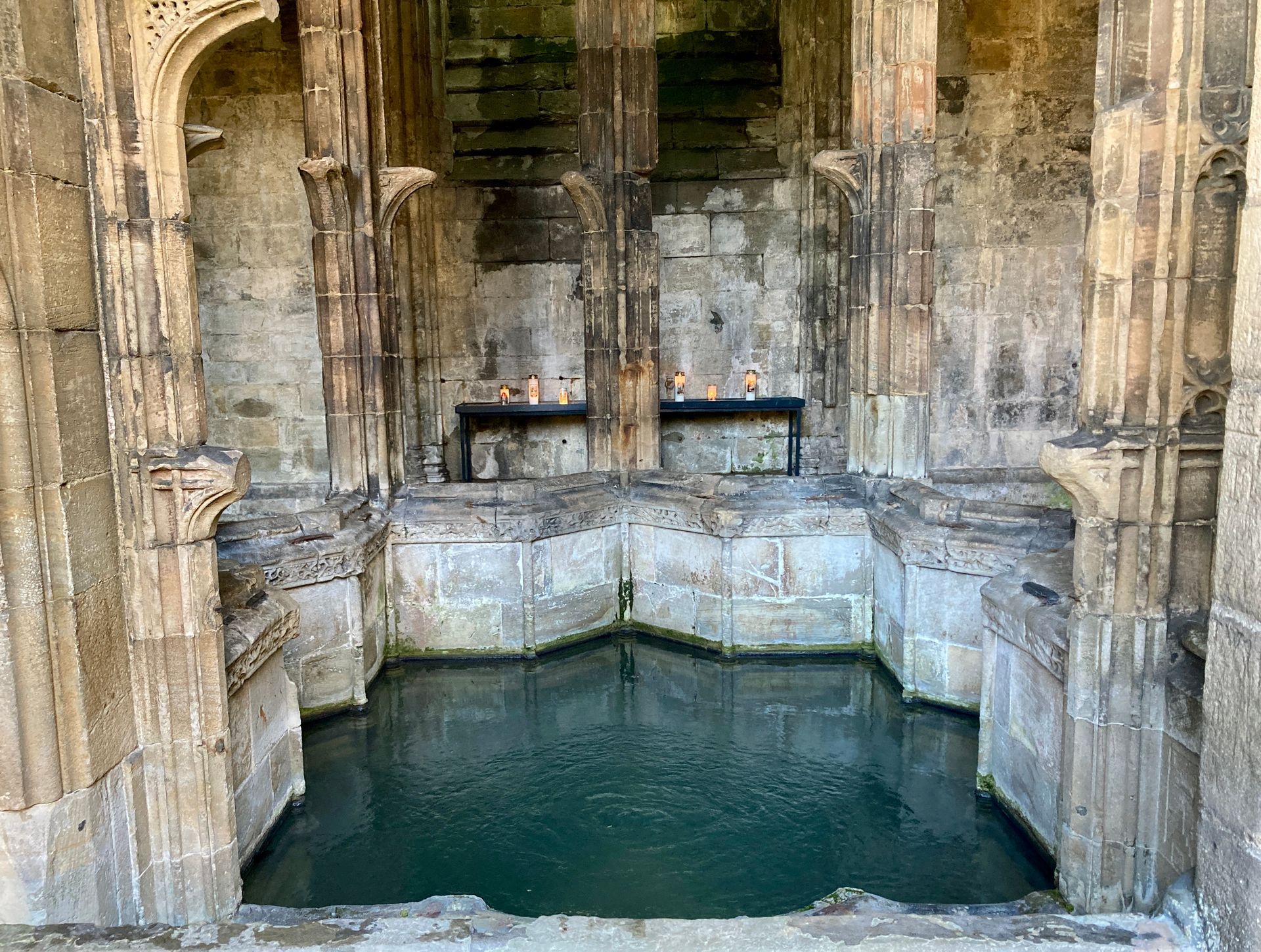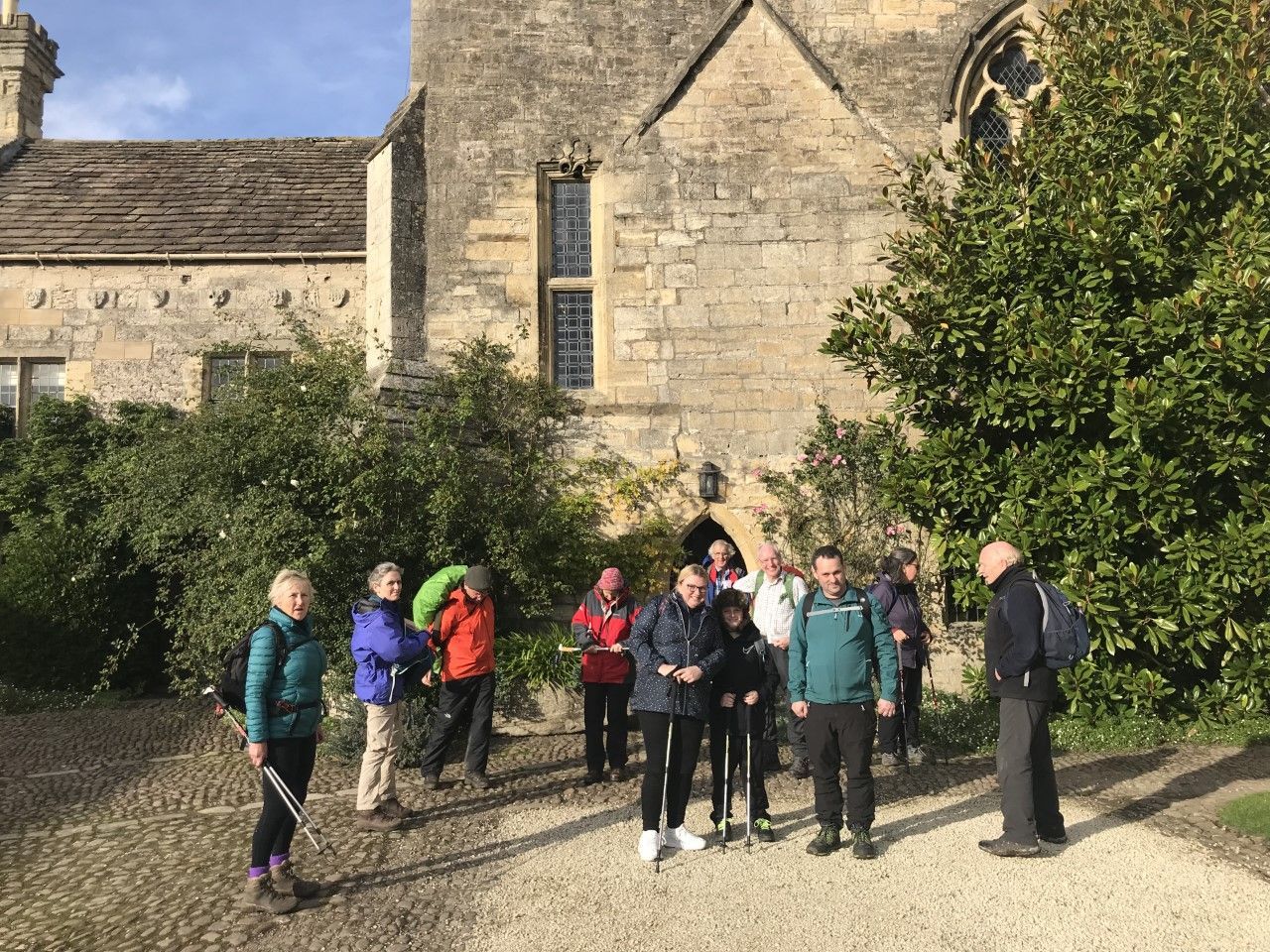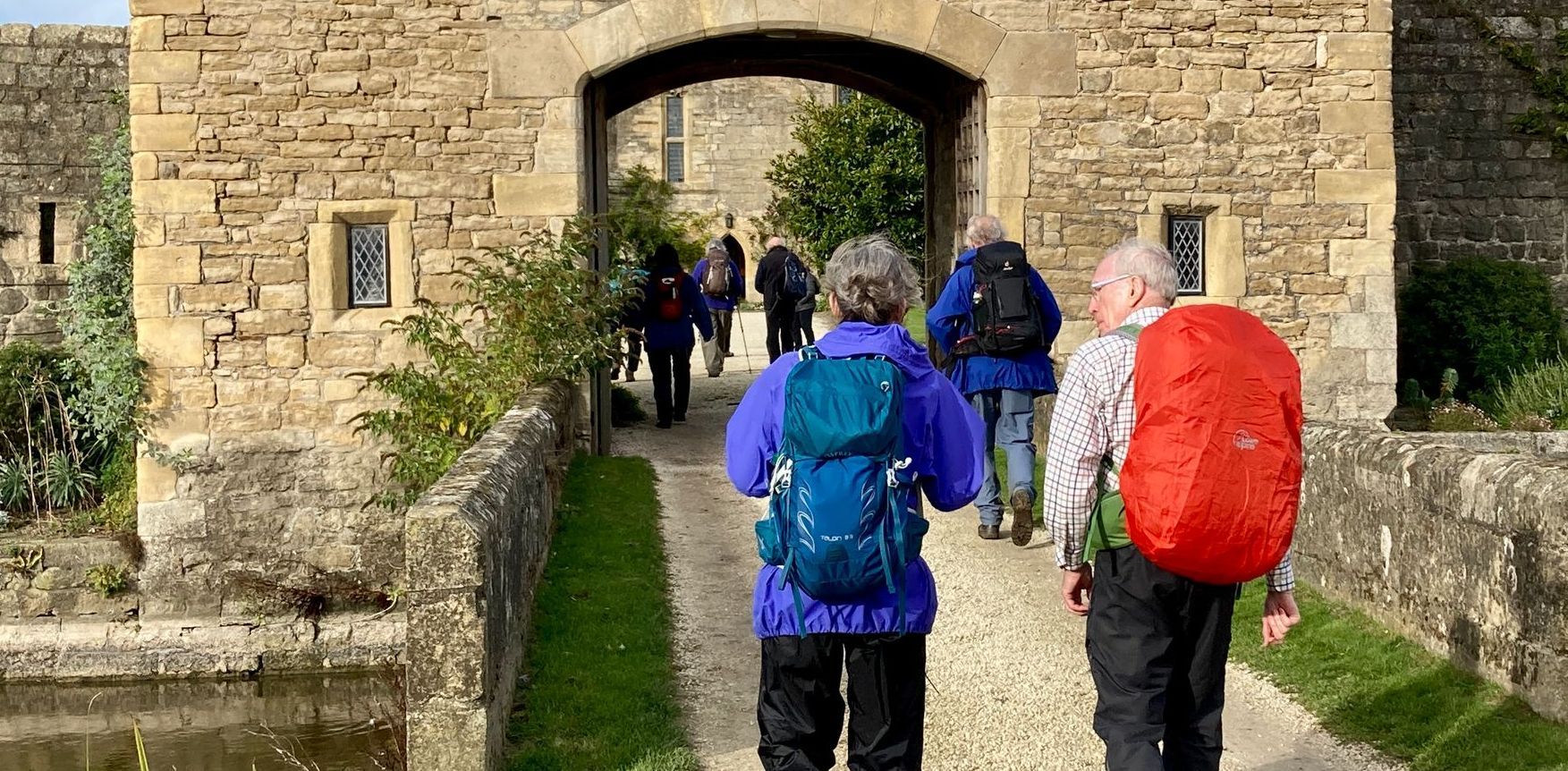The Holywell Way
A Pilgrim Way for the Diocese of Wrexham from the Cathedral Our Lady of Sorrows in Wrexham to the National Shrine of St Winefride in Holywell

The National Shrine of St Winefride, Holywell
About the route
St Winefride’s Well at Holywell is believed to be the only British shrine that has a history of uninterrupted pilgrimage from the Middle Ages to the present day.
The Way is north from the Cathedral to join the Wat's Dyke Way which then passes through a valley beside the River Alyn to the villages of Caergwrle and Hope. After 10 miles the Pilgrim Way diverges from the Wat's Dyke Way to visit the Church of Our Lady of the Rosary in Buckley, rejoining the Wat’s Dyke Way just over a mile after this. On leaving the village of Sychdyn the Wat's Dyke Way diverts from the line of the Dyke to take in a Celtic hill fort at Rhosesmor. The Pilgrim Way takes a more direct route, but the two paths coincide again shortly before crossing the A55 North Wales Expressway. After this the path follows an impressive section of the Dyke.
The Way ends at the Shrine of St Winefride in Holywell, but pilgrims may wish to walk on to Basingwerk Abbey, the ruins of a C12 Cistercian monastery (1.0 miles). This is the start of the North Wales Pilgrim’s Way.
Pilgrims can also follow the North Wales Pilgrim's Way for 2.5 miles to visit the Shrine of St Padre Pio at Pantasaph.
You can find out more about the Way and download the GPX file by clicking on the LEARN MORE tab in the
interactive map below
Guidance
Using the tabs in this section you can find the information you need for your pilgrimage.
The Outer Way provides practical advice about the route.
The Inner Way describes the spiritual highlights.
Using the button below you can download details of the inner and outer ways and the walking guidance and maps.
Stages: route, food & drink, accommodation and public transport
1. The Cathedral of Our Lady of Sorrows, Wrexham to Hope Parish Church – 6.8 miles
After leaving Wrexham the route is through quiet countryside, mainly following the Wat’s Dyke Way. There is a route diversion which includes a short stretch beside a busy road, but there is pavement. Wrexham Cathedral can be reached by foot from Wrexham railway and bus stations. There are plenty of pubs, cafés, restaurants and some accommodation in Wrexham. There are pubs at Cefn-y-Bedd, Caergwrle and Hope and a small supermarket at Hope. There are railway stations at Cefn-y-Bedd and Caergwrle and Hope. There is a bus from Buckley to Wrexham passing through the 3 villages on the route.
2. Hope Parish Church to the Church of Our Lady of the Rosary, Buckley – 4.9 miles
The route is along quiet lanes and paths through farmland. There are cafés, shops and pubs in Buckley. There is a railway station at Penyffordd and buses from Buckley to Mold and Wrexham. There are bus stops by the Church of Our Lady of the Rosary.
3. The Church of our Lady of the Rosary, Buckley to the A55 North Wales Expressway – 7.3 miles
The route is urban until New Brighton, then over gently rolling farmland. There is a hotel at New Brighton and a pub at Sychdyn.
4. The A55 North Wales Expressway to the National Shrine of St Winefride, Holywell – 6.1 miles
After some quiet lanes the route follows a spectacular section of Wat’s Dyke, then across farmland to reach Holywell. There are no facilities enroute. In Holywell there are cafés, pubs and large supermarkets. The Bridgettine Sisters runs St Winefride’s Guest House, which is located between the Shrine and central Holywell. There are buses from Holywell to the railway station at Flint and to and from Basingwerk Abbey.
Public transport links
Trains:
https://www.nationalrail.co.uk/
Coaches:
https://www.nationalexpress.com/en
Buses:
Pilgrim people and places
NB Many churches are closed during daylight hours. If you would like to visit the churches and shrines it is best to check the parish website first. You can also email or phone the parish office to see is someone would be willing to open the church. Please be aware that many priests cover more than one church and so may live many miles away.
The Cathedral of Our Lady of Sorrows, Wrexham
From 1824 Mass was celebrated at Wrexham in a house in Market Street and later in Cutler’s Entry. In 1828 a chapel was built in King Street at the expense of Richard Thompson, a member of an English family of ironmasters who had moved from Wigan to help develop the coal and iron industries. When the congregation became too large for the chapel, Thompson provided funds for the building of the present church. E. W. Pugin was appointed as architect for the church and presbytery in 1857 at the age of 23, making it one of his earliest commissions. In 1898 the Diocese of Menevia was created with Wrexham as the episcopal seat, and Our Lady of Sorrows was consecrated as pro-cathedral in 1907. In 1957 a northwest porch and sacristies were added, and further alterations and additions followed in 1966. The tower has been rebuilt twice due to mining subsidence. Since 1987 the building has been the Cathedral of the Diocese of Wrexham. It houses the shrine of St Richard Gwynn, who was executed for his faith on 15 October 1584 and is one of Forty Martyrs of England and Wales canonised by Pope Paul VI in 1970.
The Church of Our Lady of the Rosary, Buckley
Land for the first Catholic church at Buckley was acquired in the early 1890s. The church opened in 1893 and was initially served by clergy from Mold. The presbytery was built by Fr Pochard, a Frenchman, who was parish priest from 1906 to 1929. Following the expansion of Buckley in the 1960s & 70s, the church became too small, and a new site was found on Jubilee Road. Building started in January 1999 and the church opened early the following year. The old church now serves as a centre for Bible Christians. The church provides a dignified setting for the liturgy and has a spacious parish hall.
The Church of St Winefride, Holywell
For a long time the care of the shrine and parish were shared by the Jesuits and the secular clergy and services were held in two inns that stood on what became the site of the church. In 1808 a chapel was opened at Ye Olde Star Inn, as it was then known. This was remodelled in 1832-33 to serve as a presbytery when the present neo-classical church was built. In 1909 the building was enlarged and re-orientated through 180° so that the entrance was from Well St. The Lady Chapel, baptistery and shrine were added in 1911.
The National Shrine of St Winefride, Holywell
St Winefride’s Well is believed to be the only British shrine that has a history of uninterrupted pilgrimage from the Middle Ages, through the period of Catholic persecution, to the present day. St Winefride was a C7 Christian martyr who, according to legend, was decapitated by a lustful prince and then miraculously restored to life. The well is said to have sprung up where her head hit the ground. The first reference to Holywell as a place of pilgrimage is 1115. The well was granted to the Benedictine monks of Basingwerk Abbey in 1246, who held it until the suppression of the monasteries. Construction of the crypt is attributed to Margaret Beaufort, the mother of King Henry VII. After the Reformation several attempts were made by the authorities to prevent Catholic pilgrimage to the well, but devotions continued. From the C18 the well attracted secular visitors because of the belief that the well-water had natural healing properties due to its mineral content. Two bathhouses were built in 1869. In 1917, the well dried up because of local mining operations and water had to be diverted from a new underground source. In 2023 Holywell was accorded the status of a national shrine by the Catholic Bishops’ Conference of England & Wales.
The abbey was part of a network of Cistercian settlements which once dotted Wales. It was founded in 1131 and extensively remodelled in the C13. This abbey came to hold land in Derbyshire. After the suppression of the monasteries in 1536 the abbey’s assets were plundered and sold and the site abandoned. Today the ruins are managed by Cadw – the national Welsh heritage agency. The oldest part of the abbey is the C12 chapter house, with remains of the benches where monks sat for daily readings. The most impressive surviving room is the monks’ dining hall. Basingwerk Abbey is the starting point for the North Wales Pilgrim’s Way that stretches along the Llŷn Peninsula to Bardsey Island, the ‘Island of 20,000 Saints’.
Prayer of St. Winefride
O blessed Winefride,
pure virgin and glorious martyr,
so especially chosen, so divinely graced
and so wonderfully restored from death to life!
Hope of all that fly unto you
with full confidence and humility!
We, though, unworthy, yet your devoted pilgrims,
make our petitions to you.
Sanctuary of piety, look upon us with patient eyes;
receive our prayers, accept our offerings,
and present our supplications at the throne of mercy,
that through thy powerful intercessions
God may be pleased to bless our pilgrimage,
and to grant our requests and desires;
through Christ our Lord.
Amen.
ABOUT THE DIOCESE OF WREXHAM
Christianity spread through north Wales during the period of Roman occupation. As the east of Britain became subject to the pagan Anglo Saxon invasion, Wales remained Christian. When St Augustine was sent to convert the English at the beginning of the C6 he met the British Bishops and Abbots and made demands for change on the Welsh Church which created differences which lasted for over 150 years.
After the Norman invasion of 1066, four Welsh dioceses were created. Monasteries founded by the Cistercians, Franciscans and Dominicans flourished until their suppression by Henry VIII and the Welsh Church became part the new Church of England with the king as its supreme head.
Faced with persecution and deprivation, the Catholic Faith struggled to survive in Wales. Refusal to attend the new services brought fines and imprisonment and missionary priests were hunted down, imprisoned and sentenced to death. From 1688 the Holy See appointed Vicars Apostolic to the Western District which included Wales and Herefordshire. In 1840 Herefordshire, Monmouthshire and Wales became the Welsh District. In 1850 with the diocese of Newport and Menevia was created. In 1895 the Newport diocese was defined as including Glamorgan, Monmouth and Hereford. A Vicar Apostolic was responsible for the remaining territory until 1898, when it became the diocese of Menevia. In 1916 the Cardiff Province was established, with the Metropolitan Archdiocese of Cardiff and Menevia as its suffragan see.
In 1987 Pope John Paul II established the new Diocese of Wrexham by restructuring the Diocese of Menevia. It consists of the Counties of Aberconwy and Colwyn, Anglesey, Denbighshire, Flintshire, Gwynedd, Wrexham and the District of Montgomery in the County of Powys.






